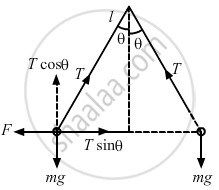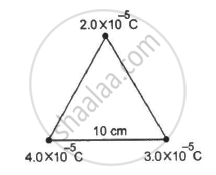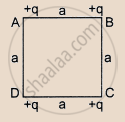Advertisements
Advertisements
Question
Two identical balls, each with a charge of 2.00 × 10−7 C and a mass of 100 g, are suspended from a common point by two insulating strings, each 50 cm long. The balls are held at a separation 5.0 cm apart and then released. Find.
(a) the electric force on one of the charged balls
(b) the components of the resultant force on it along and perpendicular to the string
(c) the tension in the string
(d) the acceleration of one of the balls. Answers are to be obtained only for the instant just after the release.
Solution
Given:
Magnitude of the charges, q = 2.0 × 10−7 C
Separation between the charges,
\[r = 5 \times {10}^{- 2} \]m
Length of the string,
\[l = 50 \text{ cm }= 50 \times {10}^{- 2}\] m
Mass of the balls, m = 100 g = 0.1 kg

(a) By Coulomb's Law, the electric force,
F = `("Kq"_1"q"_2)`
= `(9 xx 10^9 xx 2 xx 10^(-7) xx 2 xx 10^(-7))/((5 xx 10^(-2))^2)`
= `36/25 xx 10^(-1)`
= 0.144 N
(b) The components of the resultant force along it is zero because mg balances Tcosθ,as shown in the figure. So,
F = Tsinθ
⊥ to the string Fnet = fe cosθ − mg singθ
= `0.144(1) − 100/1000 xx 10 xx 1/20`
= `0.144 - 1/20`
= 0.094 N
(c) Tension in the string,
Tsinθ = F ..(1)
Tcosθ = mg ...(2)
Squaring equations (1) and (2) and adding, we get
\[T^2 = F^2 + \left( \text{mg } \right)^2 \]
\[ = \left( 0 . 144 \right)^2 + \left( 0 . 1 \times 9 . 8 \right)^2 \]
\[ \Rightarrow T^2 = 0 . 986\] N
(d) the acceleration of one of the balls
a = `"Fnet"/"m"`
= `0.094/0.1`
= 0.94 m/s2
APPEARS IN
RELATED QUESTIONS
- Two insulated charged copper spheres A and B have their centers separated by a distance of 50 cm. What is the mutual force of electrostatic repulsion if the charge on each is 6.5 × 10−7 C? The radii of A and B are negligible compared to the distance of separation.
- What is the force of repulsion if each sphere is charged double the above amount, and the distance between them is halved?
Write any two important points of similarities and differences each between Coulomb's law for the electrostatic field and Biot-Savart's law of the magnetic field ?
Two equal charges are placed at a separation of 1.0 m. What should be the magnitude of the charges, so that the force between them equals the weight of a 50 kg person?
Estimate the number of electrons in 100 g of water. How much is the total negative charge on these electrons?
NaCl molecule is bound due to the electric force between the sodium and the chlorine ions when one electron of sodium is transferred to chlorine. Taking the separation between the ions to be 2.75 × 10−8 cm, find the force of attraction between them. State the assumptions (if any) that you have made.
A hydrogen atom contains one proton and one electron. It may be assumed that the electron revolves in a circle of radius 0.53 angstrom (1 angstrom = 10−10 m and is abbreviated as Å ) with the proton at the centre. The hydrogen atom is said to be in the ground state in this case. Find the magnitude of the electric force between the proton and the electron of a hydrogen atom in its ground state.
Two particles A and B possessing charges of +2.00 × 10−6 C and of −4.00 × 10−6 C, respectively, are held fixed at a separation of 20.0 cm. Locate the points (s) on the line AB, where (a) the electric field is zero (b) the electric potential is zero.
A water particle of mass 10.0 mg and with a charge of 1.50 × 10−6 C stays suspended in a room. What is the magnitude of electric field in the room? What is its direction ?
Three identical charges, each with a value of 1.0 × 10−8 C, are placed at the corners of an equilateral triangle of side 20 cm. Find the electric field and potential at the centre of the triangle.
How much work has to be done in assembling three charged particles at the vertices of an equilateral triangle, as shown in the figure?
Write a short note on superposition principle.
Explain in detail Coulomb’s law and its various aspects.
Two-point charges of + 0.2 µµC and -0.2 µµC are separated by 1 o8 m. What is the value of the electric field at an axial point at a distance of 0.1 m from their mid-point?
Two positive charges ______.
Two identical thin rings, each of radius a meter, are coaxially placed at a distance R meter apart. If Q1 coulomb and Q2 coulomb are respectively the charges uniformly spread on the two rings, the work done in moving a charge q coulomb from the centre of one ring to that of the other is ______.
Four equal charges q are placed at the four comers A, B, C, D of a square of length a. The magnitude of the force on the charge at B will be ______.

Coulomb's law is given by F = k q1q2 rn where n is
The capacity of an isolate conducting sphere of radius R is proportional to
